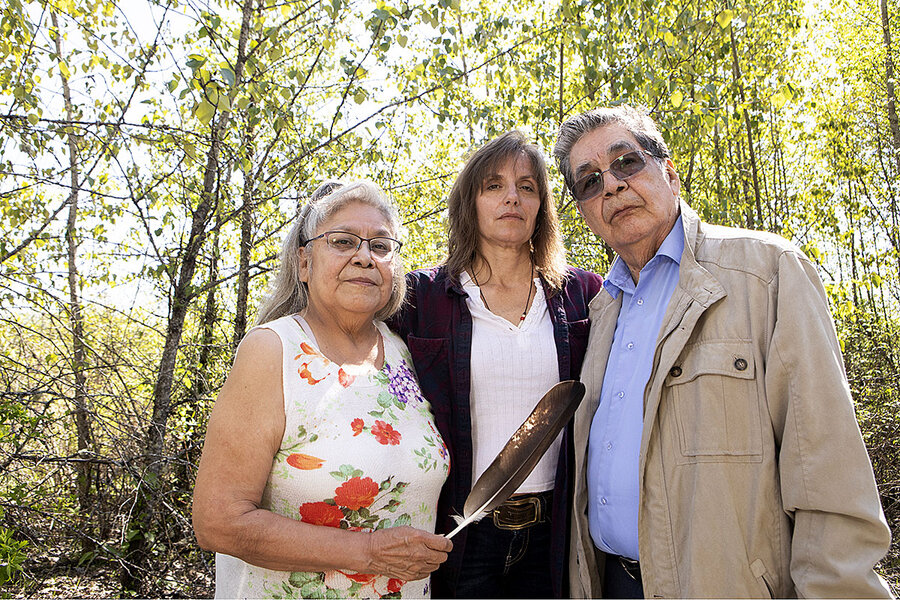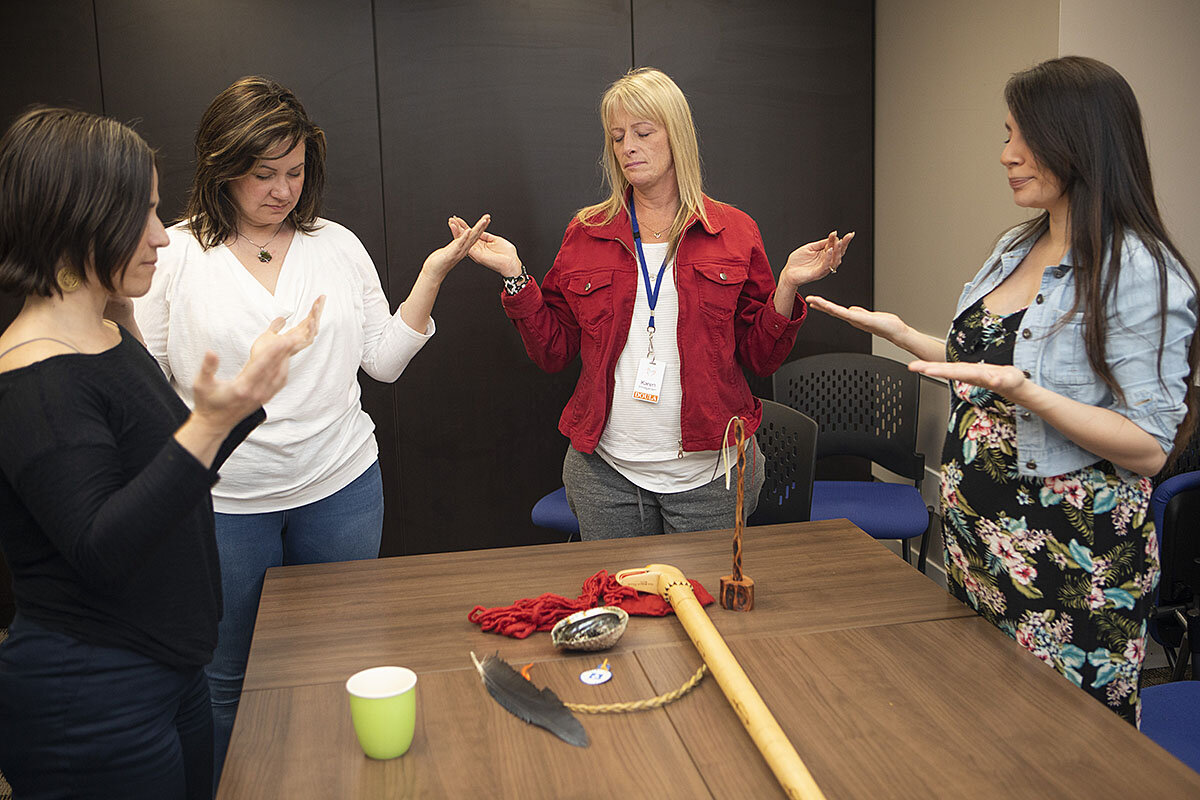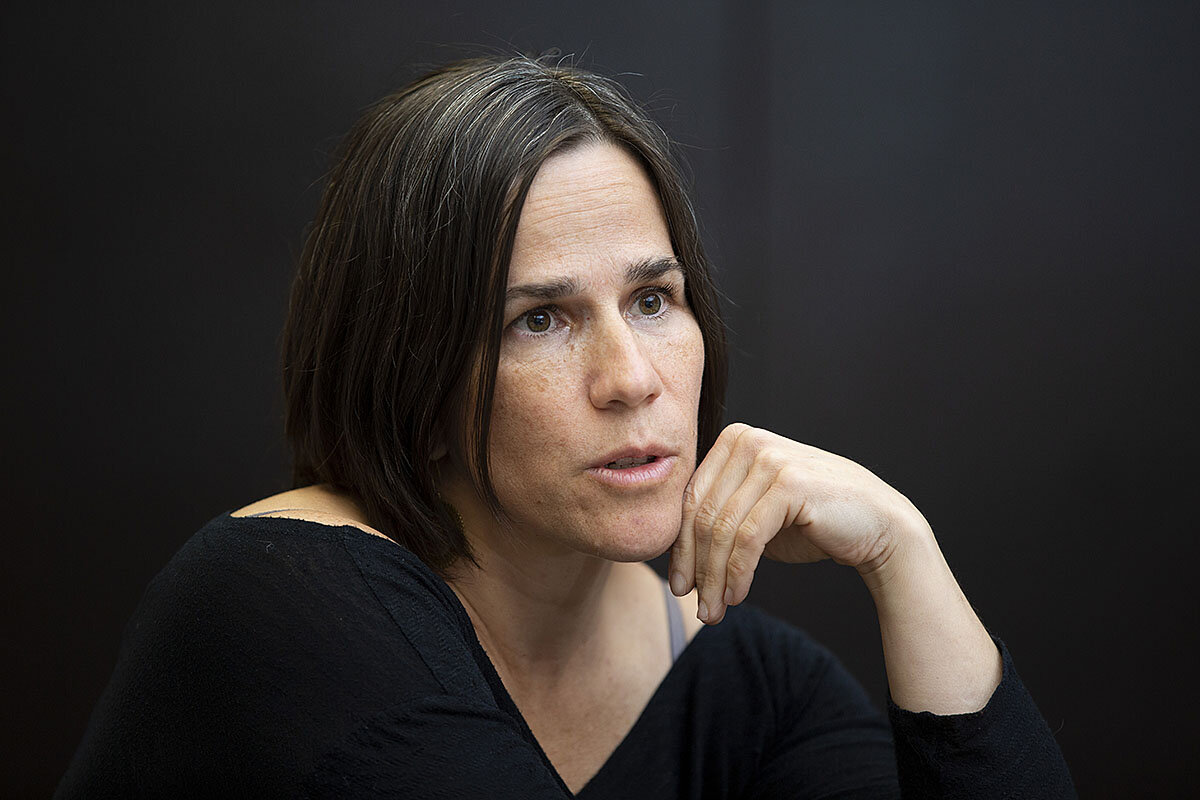Canada’s indigenous seek to break vicious cycle tearing families apart
Loading...
| Duncan, British Columbia
Although Canada’s indigenous population has more visibility in Canadian political and cultural life than America’s, colonial policies have a dark history here. Traumas from earlier assimilation policies have generated a vicious cycle: Generational issues often see indigenous children born into more precarious family lives, yet those families become victims of a child-welfare system built on centuries of stigma and bias.
In British Columbia last year, of all children “apprehended” at birth – in which the government takes children from their mothers as a last-resort protection – 55% were indigenous. In the 2016 census, 5.9% of the province’s population identified as aboriginal.
Authorities at the top recognize the challenge, but the indigenous community says it’s not enough. It is taking action now, helping to reclaim traditional cultural and family practices to try to break the cycle. A key feature is peer support by other indigenous women who have fought to reunite their families. “It’s more about how we walk with you. And we call it companion care,” says Patricia Dawn, founder of the Red Willow Womyn’s Society. “It’s returning to and honoring that everybody has the right to dignity and respect.”
Why We Wrote This
Decades of mistreatment of Canada’s indigenous communities have led to precarious family lives, which in turn have put families at risk of being split up by the government. Now indigenous groups are trying to stop the cycle.
Joe Norris, at 81, still wakes up with blood on his pillow some mornings, the result of a blow to the ear that he received as a boy for speaking his indigenous language at the residential school where so many of his generation were sent.
The stain represents the violence of forcefully being taken away from his family to a boarding school intended to assimilate indigenous peoples. But it also represents the bonds to his grandfather, who brought him home and taught him the language, customs, and culture of his Halalt First Nation on Vancouver Island.
“I’m glad he did. I don’t think I would have made it at that school; it would have killed me,” says Mr. Norris, a hereditary chief and retired businessman.
Why We Wrote This
Decades of mistreatment of Canada’s indigenous communities have led to precarious family lives, which in turn have put families at risk of being split up by the government. Now indigenous groups are trying to stop the cycle.
Today he is playing the role his grandfather did for him, as an elder working with the Red Willow Womyn’s Society in the Cowichan Valley, a grassroots network working to stop “child apprehensions,” in which the government takes children from their mothers as a last-resort protection, the government maintains, of the children. The practice disproportionately affects indigenous families. “What we’re looking at is to reclaim our culture, our language, our teachings as a native people.”
Although Canada’s indigenous population has more visibility in Canadian political and cultural life than America’s, colonial policies have a dark history here. Traumas from assimilation policies from the 19th and 20th centuries have generated a lasting vicious cycle: Generational issues often see indigenous children born into more precarious family lives, yet those families become victims of a child-welfare system built on centuries of stigma and bias. In British Columbia last year, of all children apprehended at birth, 55% were indigenous, according to provincial government data. In the 2016 census, 5.9% of the province’s population identified as aboriginal.
Authorities at the top recognize the challenge, but members of the indigenous community, from grassroots activists to elders to doulas, say it’s not enough. They are taking action now, helping to reclaim traditional cultural and family practices to try to break the cycle. “People started saying, ‘This is enough. We are literally falling apart,’” says Marnie Turner, an indigenous doula working in the Vancouver area for indigenous women.
Canada’s residential schools
Canada’s residential school system was established in the 19th century as a network of government-sponsored religious schools, the majority of them Roman Catholic, aimed at assimilating indigenous children into Euro-Canadian society. But according to the 2015 findings of a Truth and Reconciliation Commission, the establishment and operation of residential schools is best described as “cultural genocide.” An estimated 150,000 First Nations, Inuit, and Métis children were removed from their homes; the last school did not close down until 1996. (The government formally apologized for the schools in 2008, when it set up the Truth and Reconciliation Commission.)
In the 20th century, families were split again by what is called the “Sixties Scoop”: mass adoptions of First Nations and Métis children in Canada. And many see disproportionate child apprehensions as the 21st century iteration in the guise of child protective services.
“It’s an echo of residential schools,” says Patricia Dawn, founder of the Red Willow Womyn’s Society, which began a decade ago as a peer support group for indigenous women. “We’re still dealing with this colonial mind, that we’re too drunk. We’re not smart. We need to be helped.”
Canada’s female indigenous population is particularly mistreated, as it has historically been vulnerable to violent and sexual abusers, further tearing families apart. Canada's National Inquiry Into Missing and Murdered Indigenous Women and Girls (MMIWG) released its final report this week, concluding that the disproportionate number of missing or murdered indigenous women over the last several decades is “genocide.”
Katrine Conroy, minister of children and family development in British Columbia, says correcting overrepresentation of indigenous children in foster care – the extent of which she says she was unaware of until becoming minister – has been a top priority since the beginning of her mandate. “I recognize that it’s just not acceptable. This has been going on for too long, and there’s systemwide assumptions and practices that have really failed indigenous kids and families.”
It’s a complex challenge, and removals are only a last resort, she says. The number of apprehensions of indigenous children at birth in British Columbia has gone down by 51 percent in the past decade (from 2008 to 2018), according to the ministry. But she recognizes mistrust toward her office has mounted over decades.
‘We see what you are doing’
Indeed, those on the ground say mainstream prejudices are rife. And few have a better view than doulas like Feona Lim, who coaches white, Asian, and indigenous mothers in Greater Vancouver.
She says she works at the same hospitals and often even with the same staff but sees vastly different attitudes depending on who her client is. “Basically the tone right away it’s like, ‘Oh, you’re having a baby! Congratulations! That must be so exciting’ to ‘When’s the last time you had a drink?’”
She’s part of a burgeoning movement of doulas who are reclaiming traditional birth practices. On a recent evening at the Fraser Region Aboriginal Friendship Centre Association in Surrey in Greater Vancouver, coordinator Corina Bye starts a meeting among doulas. They call themselves the Indigenous Birth Keepers, and they begin with a smudging ceremony using burning sage, tobacco, sweet grass, and cedar and a prayer.
They form part of a network at the Friendship Centre aimed at improving the lives of indigenous families, whether that’s with mothers seeking pre- or postnatal care or by connecting young families to elders for advice. The “wraparound” services, as they are called, are intended to re-create the family supports traditionally found in villages. “We’re just like aunties,” says Ms. Turner of the doulas.
But they are also present on the front lines where separation often happens. “We literally stand,” says Ms. Turner.
Bearing witness is a central part of the work of the Red Willow Womyn’s Society. When an apprehension is anticipated, Ms. Dawn’s telephone rings. Their growing network will make a call to action on social media, placing phone calls and emails to officials and elected leaders, to send the message, she says: “‘We see what you are doing.’ Being called out by your community is an indigenous practice.”
They interrupted four apprehensions last year, says Ms. Dawn.
In some ways, family separation has become more acute. Collette Norris, an elder and Mr. Norris’s cousin, says she struggled with alcoholism while her children were growing up. But her family stepped in to help and keep the kids safe. “They looked after them,” she says. “That’s how it worked. We just loved the kids.”
In today’s climate, she is sure her children would have been taken from her; her granddaughter’s children were taken from her while she was struggling with addiction, and her newborn was removed even after she had recovered. They have since been reunited.
Words of value
Minister Conroy says that her ministry has increased funding in the budget for foster parents, including relatives taking in family, so that children can stay within their communities. That follows legislation that was introduced last year in British Columbia intended to reduce the number of indigenous children in foster care and calls to action nationally from the Truth and Reconciliation Commission, the first five of which specifically were about child welfare.
But Ms. Dawn says that none of this has been enough, and social workers are not experienced enough with indigenous traumas – and solutions.
The Red Willow Womyn’s Society is now building up prevention work in partnership with the Canadian Mental Health Association in the regional hub, Duncan. In one case, a foster parent housed a mother with her baby instead of separating the two before they moved into temporary housing that is part of a pilot project that provides wraparound services. A key feature is peer support by other indigenous women who have fought to reunite their families. “It’s more about how we walk with you. And we call it companion care,” says Ms. Dawn. “It’s returning to and honoring that everybody has the right to dignity and respect.”
The elders like Mr. Norris play a crucial role in the healing process, she says.
If Mr. Norris’s pillow stands as a sign of the damage wrought upon him, a blanket he has from a residential school is a sign of the power of healing. “When I came out of residential school, my grandfather said that the church, the Catholic Church and government, literally buried our values. And that it’s entirely up to us to dig it up and look at it,” he says. “And there’s holes in our values. So we have patches.”
On those patches are written these words: family values, trust, respect, integrity, love, forgiveness, and responsibility.
“His grandfather told him that residential school had buried the blanket of values and traditions and that his work would be to bring that back,” says Ms. Dawn.
“We’ve been building community through this work and engaging at a community level. And so we’ve been able to birth what we’re calling social protection, because there’s enough of us now in all four directions ... and people are done. We don’t want to do this anymore.”











